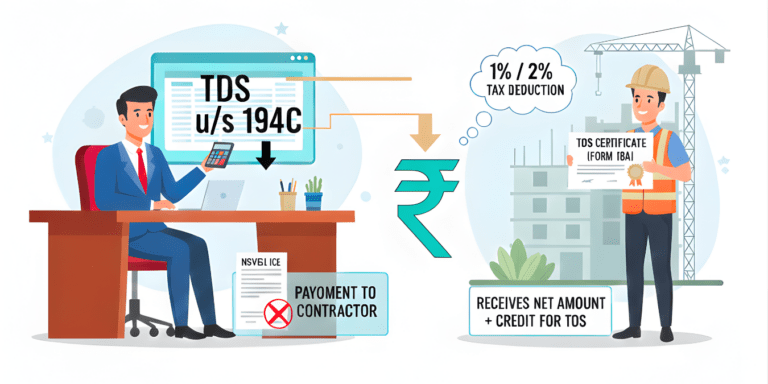
2025 Tax Filing Alert: The Shocking Reason Form 16 Alone Won't Protect You from Penalties
Most Indians blindly trust Form 16 for tax filing—until costly errors and missed refunds hit. Discover the hidden tax traps, secret deductions, and new 2025 RBI rules that could change your ITR game forever. What you don’t know can cost you thousands—uncover the missing piece today!
Your employer hands you Form 16, the trusted document summarizing your salary and tax deductions— but that piece of paper alone could cost you thousands in penalties or missed refunds when you file your Income Tax Return (ITR) in 2025. Shocking? Absolutely. Form 16 is no longer the full story. The Indian tax landscape is evolving fast—with fresh RBI policies, new tax slabs, and viral banking trends reshaping how you must prepare your finances for tax season.
What Is Form 16—and Why Indians Rely on It So Much?
Form 16 is a certificate issued by your employer that summarizes your salary income and the Tax Deducted at Source (TDS). For years, this sheet has been the primary document used by millions of salaried Indians to file their tax returns quickly without diving deep into other financial details.
- It shows total salary paid and tax deducted
- Contains details of exemptions and deductions declared to the employer
- Acts as proof of tax compliance from your end
However, many taxpayers believe Form 16 tells the whole story. In reality, it’s just the starting point.
The Shocking Hidden Gaps of Form 16 You Must Know in 2025
Here are the surprising reasons why Form 16 alone isn’t enough:
- Mismatch in TDS Reports: Your employer’s Form 16 TDS may not match the TDS reflected in your Annual Information Statement (AIS) or Form 26AS. Delays or errors in employer reporting often cause mismatches, and failing to reconcile can attract scrutiny or penalties from the Income Tax Department.
- Missing Deductions: Late submission of proof or employer oversight can mean some deductions (like HRA, LIC, or investments under Section 80C) don’t appear in Form 16 but can still be claimed while filing your ITR.
- Additional Income Not Captured: Freelance income, interest from savings accounts, fixed deposits, rental income, or capital gains won’t be reflected in Form 16. Ignoring these almost guarantees an inaccurate return.
- Non-Issuance for Certain Cases: If your income falls below the taxable limit, or if you worked as a consultant/freelancer, you may not receive Form 16 but are still liable to file an ITR based on other disclosures.
Deductions Not Covered in Form 16 to Claim in ITR
Here is a list of common income tax deductions that are not covered or fully reflected in Form 16 but can and should be claimed while filing your Income Tax Return (ITR) in India for 2025:
Key Deductions Not Covered in Form 16 to Claim in ITR (FY 2024-25 / AY 2025-26)
- Section 80C Investments Beyond Employer Records:
Investments like Public Provident Fund (PPF), Employee Provident Fund (EPF), National Savings Certificate (NSC), Life Insurance Premiums, Equity Linked Savings Schemes (ELSS), and Principal repayment of home loan made by you directly may not appear in Form 16 if you didn’t submit proofs to your employer. You can manually claim these deductions with supporting documents. - House Rent Allowance (HRA) Exemptions:
HRA exemptions depend on rent receipts and salary components; these may not be fully detailed in Form 16 and need to be claimed separately by submitting rent proofs. - Interest Income from Savings Bank Accounts:
Section 80TTA allows a deduction of up to ₹10,000 on savings account interest income. This is generally not part of Form 16 but can be claimed while filing ITR. - Medical Insurance Premiums (Section 80D):
Health insurance premium payments for self, family, and parents qualify for deductions but often these premiums are not part of your employer’s records, so not in Form 16. - Education Loan Interest (Section 80E):
Deduction for interest paid on education loans is also excluded from Form 16 since employers don’t typically track this information. - Donations to Charity (Section 80G):
Donations eligible for deduction are not captured in Form 16 and should be claimed manually with donation receipts. - National Pension System (NPS) Additional Contributions (Section 80CCD(1B)):
Contributions to NPS over and above the employer’s contribution are claimed by the employee themselves. - Standard Deduction Limit Differences:
Though standard deduction is in Form 16, confirm it reflects the current FY limit (₹75,000 in 2025). Any mismatch should be corrected manually. - Professional Tax:
Professional tax paid by you is often not reflected in Form 16 but is deductible from your taxable income. - Leave Travel Allowance (LTA):
Exemptions for LTA based on actual travel expenses are to be claimed separately with travel proofs and are often missing from Form 16.
Summary Table of Common Deductions Missing from Form 16
| Deduction Type | Section | Common Reason Missing From Form 16 |
| PPF, ELSS, LIC, NSC and other 80C items | 80C | Employee submits proof separately to employer |
| House Rent Allowance (HRA) Exemption | - | Rent receipts not always submitted |
| Savings Account Interest Deduction | 80TTA | Bank interest not employer-related |
| Medical Insurance Premiums | 80D | Paid individually, not always routed via employer |
| Education Loan Interest | 80E | Not tracked by employer |
| Donations Eligible for Deduction | 80G | Requires donation receipts |
| NPS Additional Contributions | 80CCD(1B) | Self-contributed beyond employer contribution |
| Professional Tax | - | Paid locally by employee, not employer reported |
| Leave Travel Allowance (LTA) | - | Requires travel proof, not employer-reported |
Important Note on Claiming These Deductions
You must manually fill in these deductions while filing your return, supported by respective proofs like receipts, bank statements, rent agreements, etc. These are often skipped if relying solely on Form 16, causing missed refund opportunities or excess tax liability
RBI and 2025 Tax Policy Updates Impacting Your ITR
In 2025, the RBI’s steady interest rate policy (repo rate at 5.5%) and Finance Ministry’s budget changes introduced significant tax reforms that Indians must factor outside Form 16:
- Increased Standard Deduction: The standard deduction rose to ₹75,000, reducing taxable income and requiring taxpayers to verify if their Form 16 reflects this correctly.
- Extended Filing Deadlines: With revised return filing extended from 2 to 4 years, taxpayers now have more time to claim missed deductions and correct mistakes—meaning a more detailed filing beyond just Form 16 is critical.
- New Income Tax Slabs: Relaxed slabs with exemption up to ₹12 lakh means many salaried individuals must cross-verify their salary income details beyond Form 16 to ensure correct tax liability.
Why Relying Only on Form 16 Can Cost You Penalties or Lost Refunds
- Form 16 cannot reveal mismatches in deduction claims, other incomes, or TDS reported by multiple deductors.
- Non-reconciliation between Form 16 and AIS/Form 26AS could trigger notices.
- Blindly accepting Form 16 exempts you from cross-checking unexplained deductions or income, hurting your tax efficiency.
- New RBI banking norms demand greater transparency in income and asset reporting beyond Form 16.
The Smart, Quick Steps Every Indian Must Follow for Accurate ITR Filing in 2025
To file your ITR accurately and smartly this year, don’t just depend on Form 16. Follow these fast, foolproof steps:
- Reconcile Form 16 with Form 26AS and AIS: Check the TDS credit deposited by employers and other deductors on the government portal to match Form 16 details.
- Include Other Income Sources: Add salary from multiple employers, bank interest, rental income, capital gains, and freelancing earnings.
- Claim All Eligible Deductions: Submit proofs for exemptions like HRA, medical insurance, 80C investments—even if omitted in Form 16.
- Use the Extended Timeline: Leverage the 4-year window to file revised returns as needed if you missed deductions or incomes initially.
- Consult a Tax Expert or Use Reliable Software: Ensure that all disclosures beyond Form 16 are captured flawlessly using trusted tax filing platforms or expert guidance.
- Stay Updated on RBI and Budget Changes: RBI’s stable rate policies and Budget 2025’s tax reforms significantly impact your taxable income calculations.
How Ignoring AIS vs Form 16 Led to Penalties
Here is a comparison table showing how ignoring the Annual Information Statement (AIS) versus relying solely on Form 16 can lead to penalties while filing Income Tax Returns in India:
| Aspect | Ignoring AIS | Relying Solely on Form 16 |
| Scope of Income Data | AIS contains comprehensive data from multiple sources including banks, mutual funds, employers, and other deductors, revealing all TDS and transactions. | Form 16 only includes salary and TDS details reported by the employer. |
| Risk of Missing Income | High risk of missing income sources reported in AIS but not declared in ITR, such as interest income, capital gains, freelance earnings. | Misses all income sources other than salary, leading to under-reporting. |
| TDS Mismatch Issues | Ignoring AIS may cause failure to reconcile TDS credited from various sources, triggering notices from IT Department. | Form 16 may have mismatched or delayed TDS compared to AIS, causing discrepancies. |
| Deductions and Exemptions | AIS reflects all TDS but may not show all deductions claimed; taxpayer can cross-check accordingly. | Some deductions like HRA, medical insurance, or investments may be missing or incomplete in Form 16. |
| Consequences of Non-Compliance | Penalties for under-reporting income and mismatch notices are common due to overlooking AIS data. | Risk of penalties and loss of refunds due to incomplete or inaccurate income reporting. |
| Potential Tax Refund Loss | Significant if income or TDS not reported from AIS sources but taxpayer misses claiming refunds. | Refunds may be missed if non-salary incomes or additional deductions beyond Form 16 are ignored. |
| Ease of Tax Filing Accuracy | Requires careful reconciliation of AIS against ITR data to ensure full disclosure. | Over-reliance on Form 16 simplifies filing but compromises accuracy and completeness. |
| Best Practice | Always download and reconcile AIS before filing ITR to ensure no income or TDS is omitted. | Use Form 16 as a base but cross-check with AIS and other records for full accuracy. |
Trending Banking Campaigns and Digital Tools Helping Indians Avoid This Pitfall
In 2025, leading banks in India are running smart digital campaigns highlighting:
- How to use Form 26AS and AIS for financial reconciliation.
- Promoting digital tax filing tools that integrate latest RBI policies and financial data.
- Influencer-led content breaking down tax filing beyond Form 16.
- Financial literacy initiatives encouraging taxpayers to source income data from multiple channels for full transparency.
How Future Technology Will Change Tax Filing Beyond Form 16
The RBI and Income Tax Department are fast evolving digital ecosystems that will soon integrate:
- Real-time income and TDS tracking across all financial institutions.
- AI-driven return filing aids highlighting deductions missed in Form 16.
- Enhanced mobile-friendly filing apps offering custom alerts to avoid filing errors.
The future is clear: Form 16 will become just one of many sources feeding your tax profile in a smart, secure, automated financial world.
7 Smart Takeaways for Indian Taxpayers
- Form 16 is crucial but not a full proof document for ITR filing.
- Always reconcile Form 16 with Form 26AS and AIS to avoid mismatches.
- Include all income types beyond your salary before filing.
- Claim every eligible deduction, even if not shown on Form 16.
- Use the extended 4-year window for revised returns wisely.
- Follow RBI rate policies and Budget 2025 tax reforms closely.
- Leverage digital tax tools and banking campaigns for smooth filing.
Final Thought: The Hidden Financial Move Indian Taxpayers Must Watch in 2025
As India embraces digital finance with lightning speed, a game-changing model integrating banking, investment, and tax data into a unified AI-powered dashboard is just around the corner. This "Financial Snapshot 2.0" promises to revolutionize tax filing by eliminating guesswork and manual reconciliation entirely. Imagine filing your ITR in just minutes with 100% accuracy, backed by RBI-compliant automatic tax optimization and future-ready compliance tools. Stay tuned for the next wave of fintech innovation that will make Form 16 just a part of your powerful financial arsenal, not the entire battlefield.






























